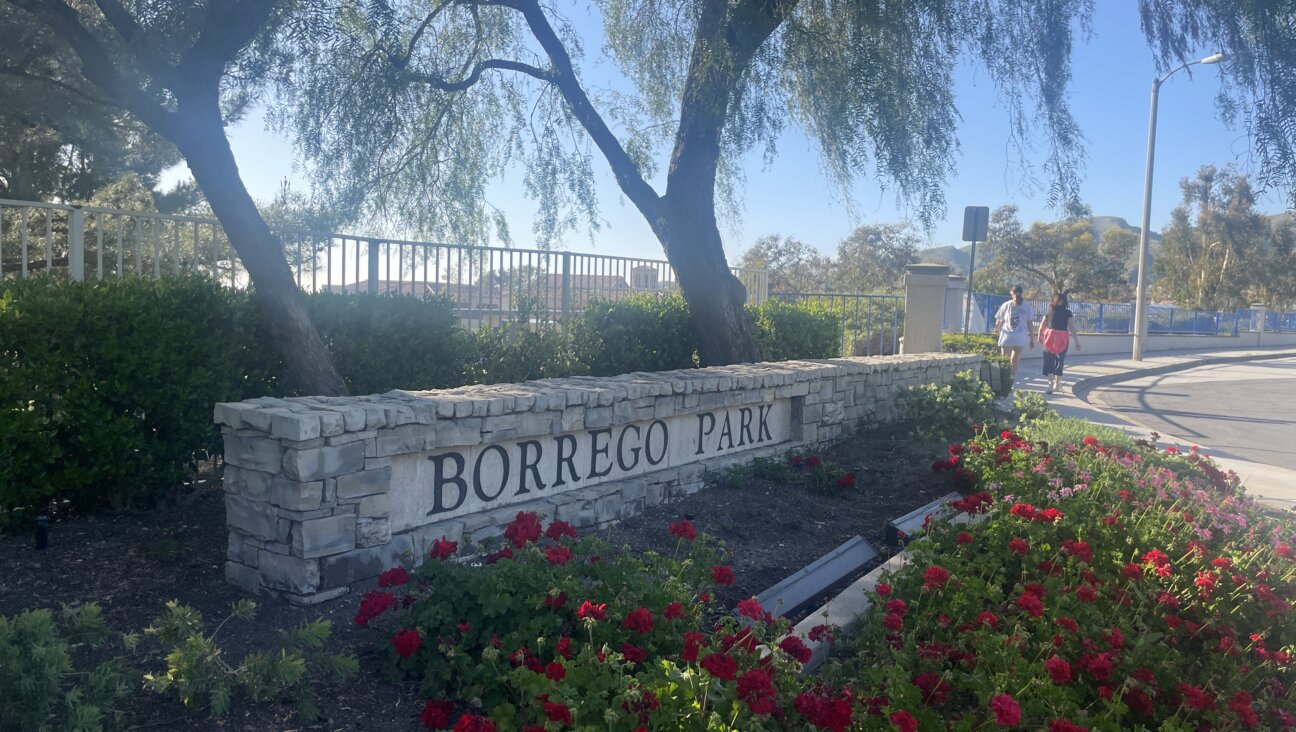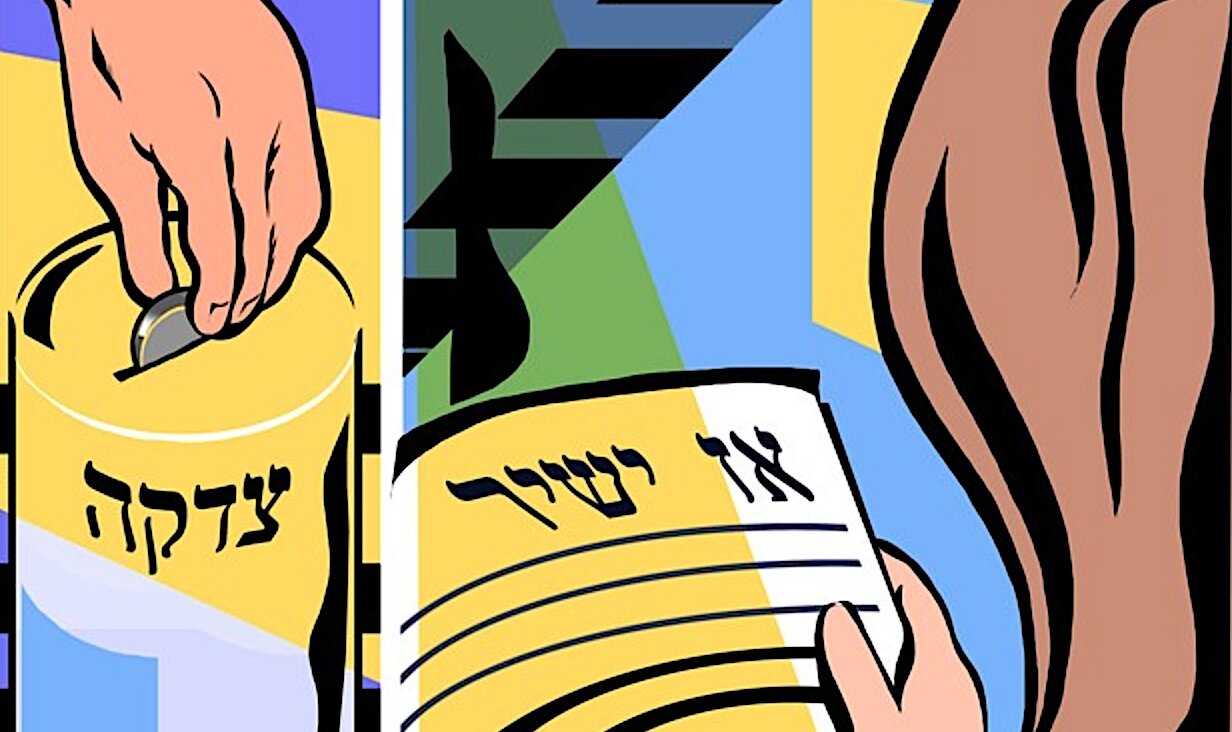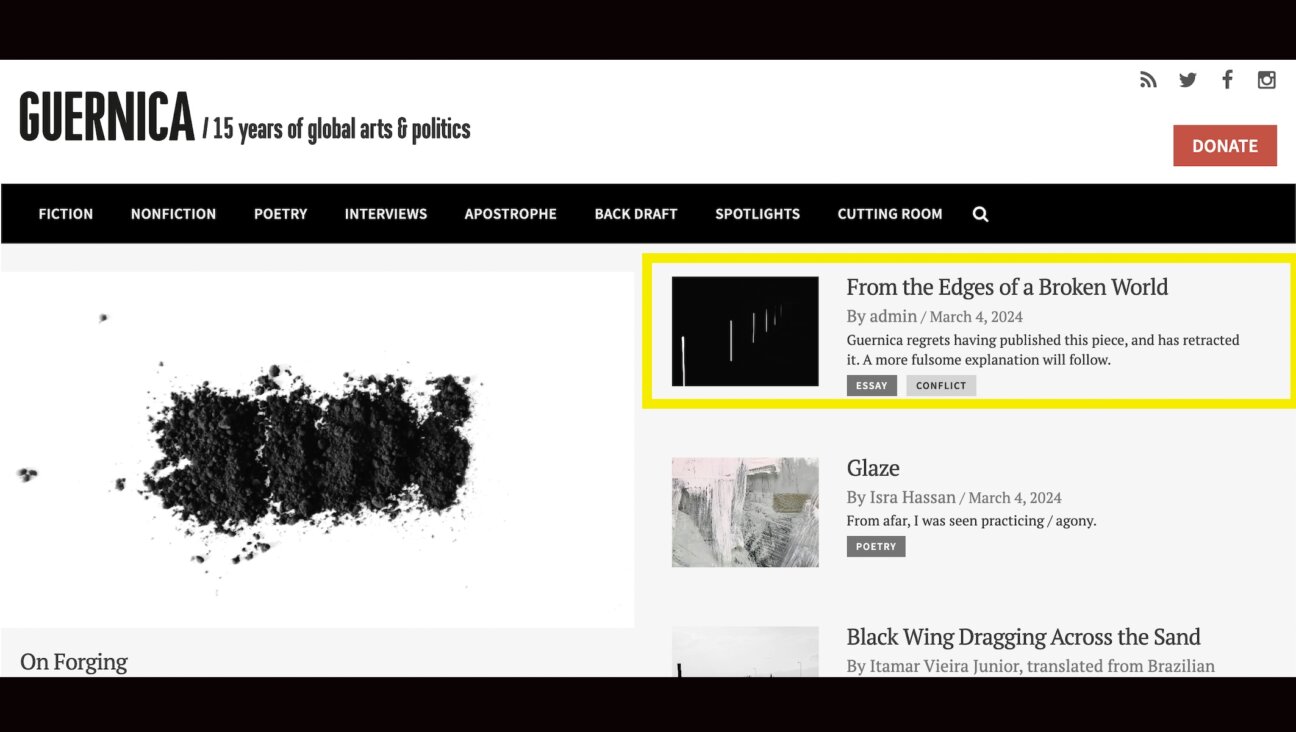Jerusalem’s Light Rail, Symbolic Unifier of Divided Holy City, Is Victim of Violence

Mad as Hell: Enraged Palestinian protester uses a pick-axe to damage Jerusalem light-rail station. Image by daniella cheslow
Jerusalem’s light rail overcame budget problems, archaeology, ancient graves and modern geopolitical conflict to open in 2011. The train’s ridership quickly exceeded expectations, and the light rail became a symbol of the casual coexistence that, albeit fragile, exists among Jerusalem’s secular Jewish, Orthodox and Palestinian populations.
Not anymore.
When the charred body of Mohammed Abu Khdeir, 16, was found on July 2 in a Jerusalem forest, residents of his neighborhood, Shuafat, poured their rage onto their local train station.
In the days following the murder, dozens of young Palestinian men with heads wrapped in scarves systematically inflicted every possible kind of damage on it. First they disabled the security cameras. Then they shattered the glass walls of the waiting stations. Pickaxes destroyed the arrival time screens. Electric saws chipped off chunks of the rail line. Burning tires melted the rubber that lines the train tracks. And a firebomb thrown under a sewer cover blew up electric wiring that controls the light rail’s traffic lights throughout the city.
Watching one such attack, a Palestinian onlooker from Shuafat told me the train was “a symbol of the Zionist enemy… one of the activities done by the Israeli occupation.”
Financially speaking, the damage is in “the tens of millions of shekels,” said Ozel Vatik, a spokesman for CityPass, the company that runs the train. Vatik said CityPass is heavily insured and has also filed paperwork for state compensation for nationally motivated damage.
It’s the worst damage to the train since it opened, he said — but it’s also not completely unpredictable.
“Everyone rides the light rail, and each car has something like 500 people,” Vatik said. “Whatever is on the street is in the train. And if there is violence in the street, in the supermarkets, I would imagine it would get to the train. “
On Tuesday, July 8, train repairmen fixed damage under the gaze of the murdered boy, his picture printed on an enormous banner hanging on a nearby mosque. The mechanics melted torn rubber back into place, righted downed electric polls and dismantled the scorched skeletons of two Shuafat train stops. Vatik said repairs are far enough along that CityPass can run test trains at night
Beyond the physical repairs, the symbolic damage is deeper.
The Jerusalem train is unique because it serves both Jews and Palestinians in a highly segregated city. The line runs from the settlement of Pisgat Zeev through the Beit Hanina and Shuafat neighborhoods of East Jerusalem, and continues downtown via Damascus Gate. Vatik could not provide numbers on Palestinian ridership, but he said about a quarter of the train’s average of 140,000 daily passengers come from Shuafat and Pisgat Zeev.
Since the day the body was found trains have stopped just before Shuafat, cutting off parts of East Jerusalem and Pisgat Zeev from downtown. When the track is repaired, Vatik said, trains will first run through Shuafat to Pisgat Zeev without stopping; service to Shuafat will resume once the stations are fixed.
The image of the train as a modern, punctual antidote to Jerusalem’s complex political quagmire gave the city a tangible boost. Vatik said pollution and noise along the train’s route plummeted while real estate prices rose.
Israel Police spokesman Micky Rosenfeld said it’s safe to ride the train. Each train car has a private security guard, part of the standard security detail year round.
There have been only a couple of incidents recently, he said. When Palestinians attacked an Israeli security guard and when a Jewish Israeli citizen pepper-sprayed a Palestinian. But Israelis have mixed feelings about using the train, and Palestinians say they fear to step aboard.
The train through downtown Jerusalem was full on July 8, less than a week after Mohammed’s murder. Saar Eini, 28 said he glances at other passengers when he steps on the train, but feels safe as the train’s iconic bell rings at each stop.
Tzvia, a 25-year-old Jewish woman who gave only her first name, said she believed God would keep her safe. Itamar Reuveni, 18, from East Jerusalem’s Gilo neighborhood, said he didn’t feel threatened on the train. As for Shuafat — “we don’t go there anyway, so it’s not my problem,” he said.
Other Israelis felt less comfortable.
In the Mahane Yehuda market that same day, Osher Avitan, 18, said he took the train to get to his job selling sesame sweet halva. His mother has been asking him not to take the train from his home in Kiryat Menachem in southwest Jerusalem, but he does it anyway.
“Every time I get on the train I check around. And if there’s anything suspicious, I get off,” Avitan said. So far, he said, there’s been nothing suspicious.
Rami Malah said traffic in the market, where he is a cashier at a liquor store, is down by a third in the past week, as many of his usual customers are afraid to ride the train or buses to the center of town.
Feelings in Shuafat were much gloomier. The mourning tents for Mohammed were near where the teen was kidnapped, just steps from the Shuafat train station. Women comforting the teen’s mother, Suha Abu Khdeir, said they avoid getting on the train because they stick out in headscarves.
Moira Jilani, an American whose Palestinian husband was killed in 2010 by Israeli border police, said she got on the train to get to Jerusalem City Hall on Sunday July 5 and noticed she was the only visibly Muslim woman on it.
For many of the residents of Shuafat, avoiding the train is part of a general feeling of lockdown. Suha Abu Khdeir said she was keeping her six surviving children — Mohammed’s siblings — at home. “One’s enough,” she said.
Mohammed’s uncle Walid Abu Khdeir said his wife has urged him not to give pocket money to their two twins; she doesn’t want them walking 30 feet to the neighborhood store.
Vatik said he has received many requests from Shuafat and Beit Hanina to return train service. But other Palestinians in Shuafat said they feel threatened by residents from Pisgat Zeev passing through their neighborhood.
“They are trying to fix the train, and we don’t want it,” said Fatme Abu Khdeir, Mohammed’s cousin. “The settlers inside [the train] are teasing us.”
City spokeswoman Brachie Sprung said on July 8 that “the train is still a sign of coexistence. In our eyes, the train still brings together all parts of the city.”
Contact Daniella Cheslow at [email protected]

I hope you appreciated this article. Before you go, I’d like to ask you to please support the Forward’s award-winning journalism this Passover.
In this age of misinformation, our work is needed like never before. We report on the news that matters most to American Jews, driven by truth, not ideology.
At a time when newsrooms are closing or cutting back, the Forward has removed its paywall. That means for the first time in our 126-year history, Forward journalism is free to everyone, everywhere. With an ongoing war, rising antisemitism, and a flood of disinformation that may affect the upcoming election, we believe that free and open access to Jewish journalism is imperative.
Readers like you make it all possible. Right now, we’re in the middle of our Passover Pledge Drive and we need 500 people to step up and make a gift to sustain our trustworthy, independent journalism.
Make a gift of any size and become a Forward member today. You’ll support our mission to tell the American Jewish story fully and fairly.
— Rachel Fishman Feddersen, Publisher and CEO
Join our mission to tell the Jewish story fully and fairly.
Our Goal: 500 gifts during our Passover Pledge Drive!























